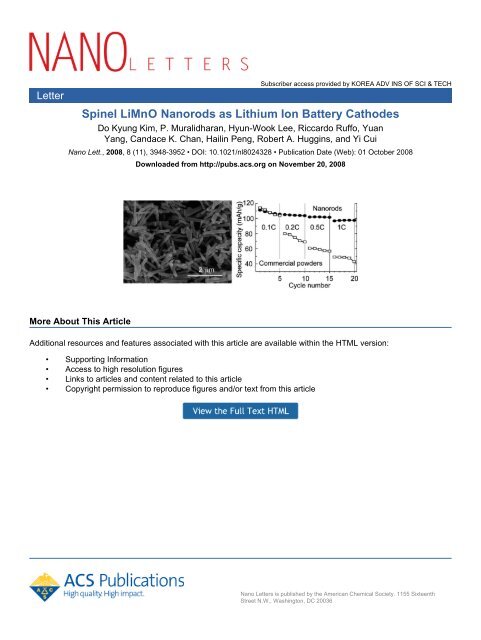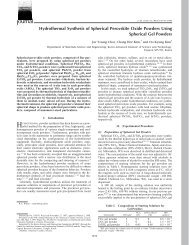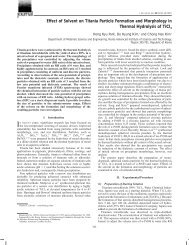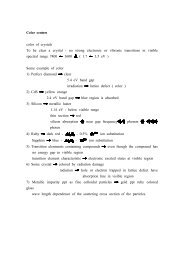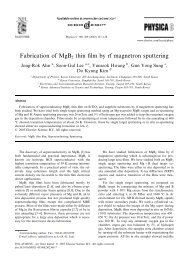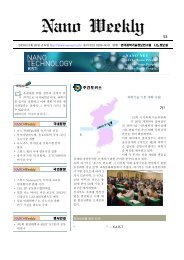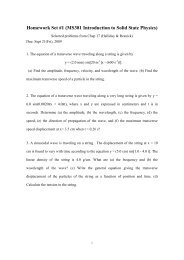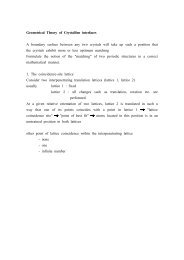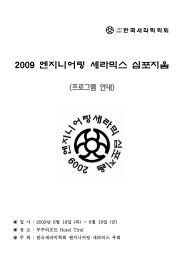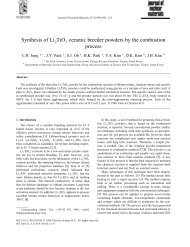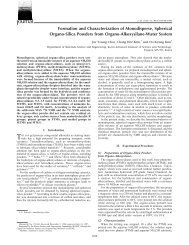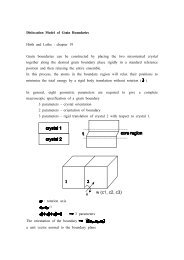Spinel LiMn2O4 Nanorods as Lithium Ion Battery Cathodes
Spinel LiMn2O4 Nanorods as Lithium Ion Battery Cathodes
Spinel LiMn2O4 Nanorods as Lithium Ion Battery Cathodes
You also want an ePaper? Increase the reach of your titles
YUMPU automatically turns print PDFs into web optimized ePapers that Google loves.
Letter<br />
2<br />
4<br />
<strong>Spinel</strong> LiMnO<br />
Subscriber access provided by KOREA ADV INS OF SCI & TECH<br />
<strong>Nanorods</strong> <strong>as</strong> <strong>Lithium</strong> <strong>Ion</strong> <strong>Battery</strong> <strong>Cathodes</strong><br />
Do Kyung Kim, P. Muralidharan, Hyun-Wook Lee, Riccardo Ruffo, Yuan<br />
Yang, Candace K. Chan, Hailin Peng, Robert A. Huggins, and Yi Cui<br />
Nano Lett., 2008, 8 (11), 3948-3952 • DOI: 10.1021/nl8024328 • Publication Date (Web): 01 October 2008<br />
More About This Article<br />
Downloaded from http://pubs.acs.org on November 20, 2008<br />
Additional resources and features <strong>as</strong>sociated with this article are available within the HTML version:<br />
• Supporting Information<br />
• Access to high resolution figures<br />
• Links to articles and content related to this article<br />
• Copyright permission to reproduce figures and/or text from this article<br />
Nano Letters is published by the American Chemical Society. 1155 Sixteenth<br />
Street N.W., W<strong>as</strong>hington, DC 20036
<strong>Spinel</strong> <strong>LiMn2O4</strong> <strong>Nanorods</strong> <strong>as</strong> <strong>Lithium</strong> <strong>Ion</strong><br />
<strong>Battery</strong> <strong>Cathodes</strong><br />
Do Kyung Kim, † P. Muralidharan, † Hyun-Wook Lee, † Riccardo Ruffo, ‡<br />
Yuan Yang, § Candace K. Chan, | Hailin Peng, § Robert A. Huggins, § and Yi Cui* ,§<br />
Department of Materials Science and Engineering, Korea AdVanced Institute of<br />
Science and Technology (KAIST), Daejeon 305-701, Korea, Dipartimento di Scienza<br />
dei Materiali, UniVersità degli Studi di Milano-Bicocca, Via Cozzi 53,<br />
20135 Milan, Italy, and Department of Materials Science and Engineering,<br />
Department of Chemistry, Stanford UniVersity, Stanford, California 94305<br />
Received August 10, 2008<br />
ABSTRACT<br />
<strong>Spinel</strong> <strong>LiMn2O4</strong> is a low-cost, environmentally friendly, and highly abundant material for Li-ion battery cathodes. Here, we report the hydrothermal<br />
synthesis of single-crystalline -MnO2 nanorods and their chemical conversion into free-standing single-crystalline <strong>LiMn2O4</strong> nanorods using<br />
a simple solid-state reaction. The <strong>LiMn2O4</strong> nanorods have an average diameter of 130 nm and length of 1.2 µm. Galvanostatic battery testing<br />
showed that <strong>LiMn2O4</strong> nanorods have a high charge storage capacity at high power rates compared with commercially available powders. More<br />
than 85% of the initial charge storage capacity w<strong>as</strong> maintained for over 100 cycles. The structural transformation studies showed that the Li<br />
ions intercalated into the cubic ph<strong>as</strong>e of the <strong>LiMn2O4</strong> with a small change of lattice parameter, followed by the coexistence of two nearly<br />
identical cubic ph<strong>as</strong>es in the potential range of 3.5 to 4.3V.<br />
<strong>Lithium</strong> ion batteries with high energy and power density<br />
are important for consumer electronic devices, portable power<br />
tools, and vehicle electrification. 1-4 LixCoO2 is a commonly<br />
used cathode material in commercial lithium ion batteries<br />
and h<strong>as</strong> a charge capacity of 140 mAh/g with a practical<br />
value of x from 0.5 to 1. However, the high cost, toxicity,<br />
and limited abundance of cobalt have been recognized to be<br />
disadvantageous. As a result, alternative cathode materials<br />
have attracted much interest. One promising candidate is<br />
spinel <strong>LiMn2O4</strong>, which h<strong>as</strong> a charge storage capacity of 148<br />
mAh/g. 5-9 <strong>Spinel</strong> <strong>LiMn2O4</strong> h<strong>as</strong> the advantages of low-cost,<br />
environmental friendliness, and high abundance.<br />
Nanostructuring battery electrode materials have been<br />
shown to enhance power performance due to the large<br />
surface-to-volumeratiothatallowsforalargeelectrode-electrolyte<br />
contact area. 10-16 Nanowires or nanorods are particularly<br />
attractive. Recently we have demonstrated examples of using<br />
Si and Ge nanowires <strong>as</strong> ultrahigh capacity anode materials.<br />
17,18 The nanowire or nanorod morphology not only h<strong>as</strong><br />
a large surface-to-volume ratio but also provides efficient<br />
one-dimensional electron transport pathways and facile strain<br />
relaxation during battery charge and discharge.<br />
* To whom correspondence should be addressed. E-mail: yicui@<br />
stanford.edu.<br />
† Korea Advanced Institute of Science and Technology (KAIST).<br />
‡ Università degli Studi di Milano-Bicocca.<br />
§ Department of Materials Science and Engineering, Stanford University.<br />
| Department of Chemistry, Stanford University.<br />
10.1021/nl8024328 CCC: $40.75 © 2008 American Chemical Society<br />
Published on Web 10/01/2008<br />
NANO<br />
LETTERS<br />
2008<br />
Vol. 8, No. 11<br />
3948-3952<br />
A wide variety of synthetic approaches have been<br />
developed for the synthesis of <strong>LiMn2O4</strong> nanoparticles,<br />
including combustion, 19,20 sol-gel, 21 solution-ph<strong>as</strong>e, 22 and<br />
templating 11 methods. Aggregated <strong>LiMn2O4</strong> nanorods have<br />
also been produced <strong>as</strong> cathodes. 23 A facile method is to<br />
chemically convert -MnO2 nanorods into <strong>LiMn2O4</strong>. Here<br />
we report the hydrothermal synthesis of single-crystalline<br />
-MnO2 nanorods and their chemical conversion into freestanding<br />
single-crystalline <strong>LiMn2O4</strong> nanorods in a simple<br />
solid-state reaction. <strong>Battery</strong> testing showed that <strong>LiMn2O4</strong><br />
nanorods have a high charge storage capacity at high power<br />
operation, which is significantly better than the commercially<br />
available powders with particle sizes around 10 µm. More<br />
than 85% of the initial charge storage capacity is maintained<br />
for over 100 cycles. The structural transformation studies<br />
showed that the Li ions intercalated into the cubic ph<strong>as</strong>e of<br />
the <strong>LiMn2O4</strong> with a small change of lattice parameter,<br />
followed by the coexistence of two nearly identical cubic<br />
ph<strong>as</strong>es in the potential range of 3.5 to 4.3 V.<br />
Experiments. Synthesis of MnO2 and <strong>LiMn2O4</strong> <strong>Nanorods</strong>.<br />
Analytical grade Mn(CH3COO)2·4H2O, Na2S2O8 (99.99%<br />
Aldrich), and deionized water were used to prepare -MnO2<br />
nanorods by hydrothermal reaction <strong>as</strong> reported elsewhere. 24<br />
All chemicals were used without further purification. In a<br />
typical synthesis, Mn(CH3COO)2·4H2O and Na2S2O8 were<br />
dissolved at room temperature with a molar ratio of 1:1 in<br />
80 mL of distilled water by magnetic stirring to form a
homogeneous clear solution. The mixed solution w<strong>as</strong> transferred<br />
to a 100 mL Teflon-lined stainless steel autoclave and<br />
heated at 120 °C for 12 h in a preheated electric oven for<br />
the hydrothermal reaction. After the reaction, the final<br />
precipitated products were w<strong>as</strong>hed sequentially with deionized<br />
water and ethanol to remove the sulfate ions and other<br />
remnants by filtration. The obtained powder w<strong>as</strong> subsequently<br />
dried at 100 °C for 12 h in air.<br />
A typical synthesis of <strong>LiMn2O4</strong> nanorods w<strong>as</strong> <strong>as</strong> follows:<br />
0.00143 moles of LiOH·H2O and 0.0028 moles of the <strong>as</strong>synthesized<br />
-MnO2 nanorods were dispersed into 2 mL high<br />
purity ethanol to form a thick slurry, ground to form a fine<br />
mixture for several hours, and dried at room temperature.<br />
The above process w<strong>as</strong> repeated two to three times to produce<br />
a well-mixed powder. The powder w<strong>as</strong> then calcined at 650,<br />
700, and 750 °C in air for 10 h.<br />
The synthesized -MnO2 and <strong>LiMn2O4</strong> nanostructures<br />
were characterized using an X-ray diffractometer (XRD,<br />
Rigaku, D/MAX-IIIC X-ray diffractometer, Tokyo, Japan)<br />
with Cu KR radiation (λ ) 0.15406 nm at 40 kV and 40<br />
mA). The size and shape of the nanostructures were observed<br />
on a field emission scanning electron microscope (FE-SEM<br />
Philips XL30 FEG, Eindhoven, Netherland), and a highresolution<br />
transmission electron microscope (HR-TEM, JEM<br />
3010, JEOL, Tokyo, Japan).<br />
Electrochemical InWestigation. The electrodes for electrochemical<br />
studies were prepared by making a slurry of 85<br />
wt % active material of <strong>LiMn2O4</strong>, 10 wt % conducting carbon<br />
black, and 5 wt % polyvinylidene fluoride (PVDF) binder<br />
in N-methyl-2-pyrrolidone (NMP) <strong>as</strong> the solvent. The slurry<br />
w<strong>as</strong> applied using a doctor-blade onto an etched aluminum<br />
foil current collector and dried at 100 °C for 12 h in an oven.<br />
The coated cathode foil w<strong>as</strong> then pressed to form a uniform<br />
layer and cut into a square sheet.<br />
The electrochemical performance of the <strong>LiMn2O4</strong> w<strong>as</strong><br />
investigated inside a coffee bag (pouch) cell <strong>as</strong>sembled<br />
in an argon-filled glovebox (oxygen and water contents<br />
below 2 and 0.1 ppm, respectively). <strong>Lithium</strong> metal foil<br />
(Alfa Aesar) w<strong>as</strong> used <strong>as</strong> the anode. Typical cathode<br />
loading w<strong>as</strong> 1.5 mg/cm 2 . A 1 M solution of LiPF6 in<br />
ethylene carbonate/diethyl carbonate (EC/DEC, 1:1 v/v)<br />
(Ferro Corporation) w<strong>as</strong> used <strong>as</strong> the electrolyte with a<br />
Celgard 2321 triple-layer polypropylene-b<strong>as</strong>ed membrane<br />
<strong>as</strong> the separator. The charge-discharge cycles were<br />
preformed at different C rates between 3.5-4.3 V at room<br />
temperature using Bio-Logic VMP3 and Maccor 4300<br />
battery testers. Electrochemical potential spectroscopy w<strong>as</strong><br />
also used to investigate the structural changes in the<br />
nanorods. The potential w<strong>as</strong> swept at steps of 3 mV from<br />
3.5 to 4.3 V and vice versa using a cut off current of 8<br />
mA/g.<br />
Result and Discussion. The XRD pattern of the hydrothermal<br />
synthesized -MnO2 corresponded to JCPDS data<br />
No. 24-0735 having tetragonal symmetry with P42/mnm<br />
space group. No additional impurity peaks were detected<br />
(Figure 1a). SEM images (Figure 1b) showed that the<br />
particles consisted of nanorods with an average diameter of<br />
90 nm and an average length of 1.5 µm.<br />
Figure 1. (a) XRD pattern and (b) SEM images of -MnO2 <strong>as</strong><br />
obtained from hydrothermal reaction.<br />
The <strong>LiMn2O4</strong> XRD diffratogram showed features of the<br />
spinel structure with Fd3m space group (JCPS card No. 35-<br />
0782), with no peaks of the -MnO2 ph<strong>as</strong>e detected (Figure<br />
2a). Thus the reaction between -MnO2 and LiOH at 700<br />
°C produced the pure <strong>LiMn2O4</strong> ph<strong>as</strong>e. To confirm whether<br />
the nanorod morphology still remained after the high<br />
temperature solid-state reaction, we performed SEM analysis.<br />
Figure 2b shows that the <strong>LiMn2O4</strong> ph<strong>as</strong>e also consisted<br />
mainly of nanorods which appear to have a larger average<br />
diameter of 130 nm but a shorter average length of 1.2 µm<br />
than the starting -MnO2 nanorods. TEM images and<br />
diffraction patterns (Figure 2c) show that nanorods are single<br />
crystalline and grow along the crystallographic<br />
direction.<br />
The electrochemical results are reported in terms of<br />
voltage versus lithium concentration (x in LixMn2O4) at<br />
constant current (Figure 3a) and voltage versus the differential<br />
capacity (dQ/dV) in potentiostatic conditions (Figure<br />
3b) for the first charge and discharge process, <strong>as</strong> well <strong>as</strong><br />
cycling properties (Figure 3c,d). During the first charge, at<br />
le<strong>as</strong>t three electrochemical processes can be observed in the<br />
incre<strong>as</strong>e of potential (Figure 3a). First, only a small number<br />
of charges are stored between the open circuit voltage<br />
(around 2.9 V) to 3.8 V, which corresponds to removing<br />
the lithium excess from Li1+xMn2O4-δ (around 3.0 V) and<br />
removing oxygen vacancies in the lattice (between 3.2 and<br />
3.7 V). 25 Second, at a potential higher than 3.9 V, the material<br />
shows the well-known behavior of lithium deintercalation<br />
from the <strong>LiMn2O4</strong> cubic spinel ph<strong>as</strong>e to the same ph<strong>as</strong>e of<br />
Li1-xMn2O4 (between 3.9 and 4.1 V, delithiation, Figure 3a).<br />
Third, a mixture of two cubic ph<strong>as</strong>es (plateau around 4.15<br />
V in Figure 3a) is formed until a second single-ph<strong>as</strong>e domain<br />
of Li0.2Mn2O4 is reached. The high potential behavior (from<br />
3.9 to 4.2 V) is reversible and two domains (single and two<br />
ph<strong>as</strong>es) are detected also during the reductive lithiation<br />
Nano Lett., Vol. 8, No. 11, 2008 3949
Figure 2. (a) XRD pattern, (b) SEM images, (c) low- and highresolution<br />
TEM of <strong>LiMn2O4</strong> nanorods <strong>as</strong> obtained from solid-state<br />
reaction between -MnO2 nanorods and LiOH·H2O.<br />
Figure 3. (a) Galvanostatic (0.1 C) first charge/discharge curve,<br />
(b) potentiostatic differential capacity vs voltage (dO/dV), (c)<br />
discharge specific capacity curve vs number of cycles for nanorods<br />
(black dots) and commercial powder electrode (white squares) at<br />
different power rates, and (d) charge (white) and discharge (red)<br />
specific capacity curve vs number of cycles for nanorod electrode<br />
at 1C rate.<br />
(Figure 3b). Moreover very good energy efficiency is<br />
observed. In fact, the potential drop between the charge and<br />
the discharge process is only 40 mV at the rate of 28.6 mA/<br />
g, indicating the f<strong>as</strong>t kinetics of the system. Since we are<br />
interested in evaluating the material <strong>as</strong> the cathode in the<br />
Li-ion battery, we used a discharge cutoff value of 3.5 V,<br />
which is similar to the requirement for commercial application.<br />
At the end of the first discharge the charge excess is<br />
lost (Coulombic efficiency of 90%). We have to consider,<br />
however, that usually a battery pack is <strong>as</strong>sembled with a<br />
certain amount of extra capacity at the cathode to compensate<br />
irreversible anode reactions taking place during the first cycle<br />
(solid electrolyte interph<strong>as</strong>e (SEI) formation, surface oxide<br />
reduction, etc.). In this c<strong>as</strong>e, it is an advantage to use the<br />
charge excess instead of loading more material at the cathode.<br />
The voltage versus dQ/dV curve clearly points out the<br />
different nature of the two processes at high potential (Figure<br />
3b). The former one, at potential ranging from 3.9 to 4.1 V,<br />
displays a bell shape peak at 4.05 V which h<strong>as</strong> full width at<br />
half-maximum (FWHM) of 55 mV while the latter process<br />
shows a spike peak at 4.15 V with just 5 mV in FWHM.<br />
The sharp peak observed in this latter peak (Figure 3b)<br />
corresponds to a flat plateau in Figure 3a, a clear indication<br />
of the coexistence of two ph<strong>as</strong>es. The difference between<br />
the two processes is also evident during the discharge scan<br />
in which they occur at potentials of 4.10 and 3.95 V with<br />
FWHM of 10 and 50 mV, respectively.<br />
The discharge specific capacity of the nanorods <strong>as</strong> a<br />
function of cycle number h<strong>as</strong> been compared with the<br />
result obtained using an electrode obtained from commercial<br />
powders (<strong>LiMn2O4</strong> electrochemical grade, Sigma<br />
Aldrich) using the same preparation route (Figure 3c), that<br />
is, the commercial electrode is a mixture of active material,<br />
carbon black, and binder in the weight ratio of 85:10:5. The<br />
charge capacity is me<strong>as</strong>ured with the power rate from 0.1 C<br />
(14.8 mA/g) to 1 C (148 mA/g). We have observed that the<br />
nanorod morphology h<strong>as</strong> a much higher charge capacity than<br />
the commercial powders at higher power rates. At the lowest<br />
current (from cycle 1 to 5) both the samples have a specific<br />
capacity around 110 mAh/g but incre<strong>as</strong>ing the rate to 0.2 C<br />
(from cycle 6 to 10) leads a large difference in performance:<br />
the specific capacity of the nanorod electrode remains almost<br />
constant between 110 and 105 mAh/g while that of commercial<br />
powder decre<strong>as</strong>es to 70 mAh/g. In most of the<br />
literature a larger amount of conductive agent (up to 20%)<br />
is added to the active <strong>LiMn2O4</strong> material and the specific<br />
discharge capacity obtained at moderate rates such <strong>as</strong> 0.2 C<br />
is comparable to that of our nanorods. However, we point<br />
out that in our nanorod c<strong>as</strong>e, reducing the amount of carbon<br />
black (10 wt %) and incre<strong>as</strong>ing the active material ratio<br />
means that more charges can be stored in the electrode<br />
regardless of the obtained <strong>LiMn2O4</strong> specific capacity. This<br />
advantage results from the one-dimensional electron transport<br />
and large surface area of the nanorods. The difference of<br />
specific charge capacity between the nanorods and commercial<br />
powders becomes larger with the further rate incre<strong>as</strong>e<br />
(Figure 3c). At the highest current (148 mA/g), the nanostructured<br />
electrode can deliver a specific charge capacity<br />
(100 mAh/g) twice of the commercial powders (50 mAh/g).<br />
These data indicate that the large surface-to-volume ratio of<br />
the nanorods enhances greatly the kinetics of the <strong>LiMn2O4</strong><br />
3950 Nano Lett., Vol. 8, No. 11, 2008
Figure 4. (a) XRD diffraction peaks of Li0.8Mn2O4 (bottom) and<br />
Li0.4Mn2O4 (top). Al refers to the peak from the Al current collector<br />
(b) low and high resolution TEM images of Li0.8Mn2O4, (c) low<br />
and high resolution TEM images of Li0.4Mn2O4.<br />
electrodes. To evaluate the cyclability of the nanorod<br />
electrode at a high rate, we have performed 100 cycles at 1<br />
C. The sample shows very good capacity retention. After<br />
50 and 100 cycles, the capacity retention is 95 and 85%,<br />
respectively (Figure 3d). The average Coulombic efficiency<br />
is 99.7%. Therefore the <strong>LiMn2O4</strong> nanorods can supply good<br />
capacity at high rates with high reversibility.<br />
To better understand the correlation between the structure<br />
and the electrochemical behavior of the nanorods, we have<br />
exploited XRD and TEM on samples with different lithium<br />
amounts. Two electrochemical cells were stopped during the<br />
first delithiation charge step (rate 14.8 mA/g, 0.1 C) to obtain<br />
compositions of Li0.8Mn2O4 and Li0.4Mn2O4, respectively. It<br />
w<strong>as</strong> observed (Figure 4a) that the Li0.8Mn2O4 sample showed<br />
an XRD diffraction pattern corresponding to a single<br />
crystalline ph<strong>as</strong>e having cubic cell parameter of 8.227 Å,<br />
which is lower than the pristine <strong>LiMn2O4</strong> (8.243 Å). The<br />
decre<strong>as</strong>e of cell parameter with delithiation h<strong>as</strong> already been<br />
observed in the literature for cubic spinel. 26 The observed<br />
shrinkage of the cell parameter continues until the composition<br />
reaches a critical value where a structural change takes<br />
place and the potential enters into the two ph<strong>as</strong>es domain at<br />
∼4.15 V. In fact, the diffraction pattern of Li0.4Mn2O4 sample<br />
appears to be lower in intensity and each reflection clearly<br />
splits into two peaks due to the presence of two different<br />
cubic ph<strong>as</strong>es in this composition domain. Two cubic cell<br />
parameters were calculated <strong>as</strong> 8.24 and 8.17 Å, respectively;<br />
therefore the sample should be a mixture of a LixMn2O4<br />
lithium rich and a LiyMn2O4 lithium poor compound where<br />
x is close to 1.0 and y might be close to 0.2. We also used<br />
TEM to compare nanorods with composition of Li0.8Mn2O4<br />
(Figure 4b) and Li0.4Mn2O4 (Figure 4c). In both samples,<br />
TEM images and electron diffraction showed that nanorods<br />
remained single crystalline. However, due to the small<br />
difference in cell parameter, the coexistence of the two-ph<strong>as</strong>e<br />
domains in the Li0.4Mn2O4 nanorods could not be resolved.<br />
The small difference in the two ph<strong>as</strong>es should facilitate the<br />
f<strong>as</strong>t kinetics of battery charging discharging, consistent with<br />
our electrochemical data.<br />
Conclusion. <strong>LiMn2O4</strong> nanorods with cubic spinel structure<br />
have been obtained with facile, low-cost and scalable<br />
hydrothermal and solid-state reaction methods. The nanorod<br />
morphology appears to be a very important step in improving<br />
the kinetic properties of the material and the nanorods are<br />
able to deliver 100 mAh/g at a high current density of 148<br />
mA/g with high reversibility and good capacity retention after<br />
100 cycles. During the charge step two fundamental processes<br />
have been detected and investigated: the delithiation<br />
proceeds in a single cubic ph<strong>as</strong>e with decre<strong>as</strong>ing of the cubic<br />
cell parameter, followed by the coexistence of two cubic<br />
ph<strong>as</strong>es with similar cell parameters.<br />
Acknowledgment. The work is supported by the Global<br />
Climate and Energy Project at Stanford and King Abdullah<br />
University of Science and Technology. C.K.C. acknowledges<br />
support from a National Science Foundation graduate fellowship<br />
and Stanford Graduate Fellowship. D.K.K. would<br />
like to thank the SBS Foundation and Korea Research<br />
Foundation (KRF-2005-005-JO9701) for supporting his<br />
sabbatical leave.<br />
References<br />
(1) Scrosati, B. Nature 1995, 373, 557.<br />
(2) Chung, S.-Y.; Bloking, J. T.; Chiang, Y.-M. Nat. Mater. 2002, 1, 123.<br />
(3) Whittingham, M. S. Chem. ReV. 2004, 104, 4271.<br />
(4) Kang, K.; Meng, Y. S.; Berger, J.; Grey, C. P.; Ceder, G. Science<br />
2006, 311, 977.<br />
(5) Thackeray, M. M.; Johnson, P. J.; Depicciotto, L. A.; Bruce, P. G.;<br />
Goodenough, J. B. Mater. Res. Bull. 1984, 19, 179.<br />
(6) Thackeray, M. M.; Dekock, A. J. Solid State Chem. 1988, 74, 414.<br />
(7) Jayalakshmi, M.; Mohan Rao, M.; Scholz, F. Langmuir 2003, 19, 8403.<br />
(8) Cabana, J.; Valdés-Solís, T.; Palacín, M. R.; Oró-Solé, J.; Fuertes,<br />
A.; Marbàn, G.; Fuertes, A. B. J. Power Sources 2007, 166, 492.<br />
(9) Luo, J.-Y.; Wang, Y.-G.; Xiong, H.-M.; Xia, Y.-Y. Chem. Mater. 2007,<br />
19, 4791.<br />
(10) Shaju, K. M.; Jiao, F.; Debart, A.; Bruce, P. G. Phys. Chem. Chem.<br />
Phys. 2007, 9, 1837.<br />
(11) Li, N.; Patrissi, C. J.; Che, G.; Martin, C. R. J. Electrochem. Soc.<br />
2000, 147, 2044.<br />
(12) Belcher, A. M.; Mao, C.; Solis, D. J. U.S. Pat. Appl. WO2005067683-<br />
A2, 2005.<br />
(13) Wang, Y.; Cao, G. Z. Chem. Mater. 2006, 18, 2787.<br />
(14) Li, Y.; Tan, B.; Wu, Y. Nano Lett. 2008, 1, 265.<br />
(15) Lee, Y. J.; Kim, M. G.; Cho, J. Nano Lett. 2008, 3, 957.<br />
(16) Arico, A. S.; Bruce, P.; Scrosati, B.; Tar<strong>as</strong>con, J. M.; Van Schalkwijk,<br />
T. Nat. Mater. 2005, 5, 366.<br />
(17) Chan, C. K.; Peng, H.; Liu, G.; McIlwrath, K.; Zhang, X.-F.; Huggins,<br />
R. A.; Cui, Y. Nat. Nanotechnol. 2008, 3, 31.<br />
(18) Chan, C. K.; Zhang, X. F.; Cui, Y. Nano Lett. 2008, 8, 307.<br />
(19) Du, K.; Zhang, H. J. Alloys Compd. 2003, 352, 250.<br />
Nano Lett., Vol. 8, No. 11, 2008 3951
(20) Kovacheva, D.; Gadjov, H.; Petrov, K.; Mandal, S.; Lazarraga, M. G.;<br />
P<strong>as</strong>cual, L.; Amarilla, J. M.; Roj<strong>as</strong>, R. M.; Herrero, p.; Rojo, J. M. J.<br />
Mater. Chem. 2002, 12, 1184.<br />
(21) Curtis, C. J.; Wang, J. X.; Schulz, D. L. J. Electrochem. Soc. 2004,<br />
151, A590.<br />
(22) Nieto, S.; Majumder, S. B.; Katiyar, R. S. J. Power Sources 2004,<br />
136, 88.<br />
(23) Cho, J. J. Mater. Chem. 2008, 18, 2257.<br />
(24) Wang, X.; Li, Y. D. J. Am. Chem. Soc. 2002, 124, 2880.<br />
(25) Gao, y.; Dahn, J. R. J. Electrochem. Soc. 1996, 143 (1), 100.<br />
(26) Ohzuku, T.; Kitagawa, M.; Hirai, T. J. Electrochem. Soc. 1990, 137<br />
(3), 769.<br />
NL8024328<br />
3952 Nano Lett., Vol. 8, No. 11, 2008


